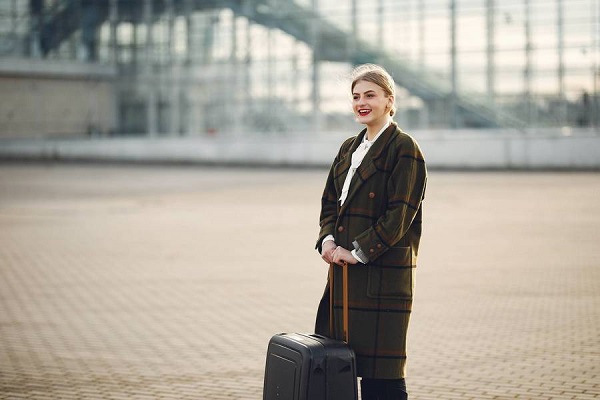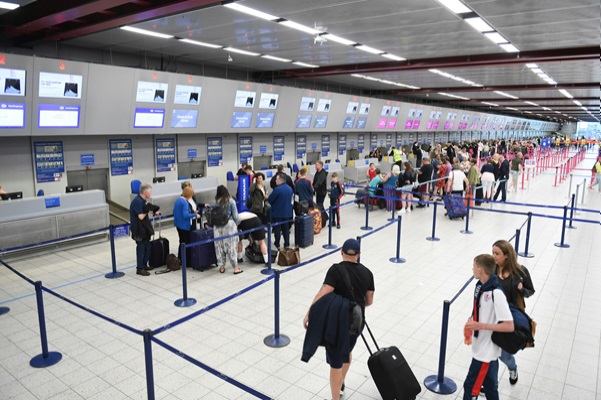Give yourself the gift of time for airport security lines
There’s no telling what might cause a delay in a security line, but if you arrive early – usually about two hours before domestic flights and three hours before international ones – you should have ample time to grab a snack and beverage or maybe catch up on work emails. Holidays, weather and other disruptions, and major events can create further delays at airport security. So, check your favorite platforms for news to see what may be happening at your departure and arrival points.
Pack right for airport security
Packing carry-on bags strategically can help streamline the security process. Consult this packing list for ideas on how to minimize what you bring. Keep your carry-on items organized in clear, reusable pouches for easy inspection.
How to breeze through airport security
The airport security process is pretty standard. Unless you’re enrolled in an expedited screening or Trusted Traveler-style program in your country of residence, you should expect to take off your shoes; remove electronic devices from bags or pouches; and limit any aerosols, gels, creams or pastes in your carry-on luggage to 3.4 ounces (100 milliliters) or less per item. Travelers enrolled in an expedited program would be allowed to bypass or forego the regular screening steps; however, they may occasionally be selected for random or additional screenings.
Always maintain awareness of your surroundings. As you move closer to the front of the screening line, look and listen for instructions from security agents. Keep your boarding pass and identification close at hand so you can present them promptly when asked. Your attentiveness can help speed up the process.
Water and the waiting game in airport security lines
Don’t wait until you’re at the front of the line to try and finish a drink. If you travel with a reusable water bottle, empty it before you enter the line. (On the bright side, many airports are investing in new scanning technology that could mean the end of the liquid limits.)
Do use your time in the line to remove metal accessories and jewelry before going through the metal detectors. You may also be instructed to remove certain outerwear items. Finally, while we all appreciate stylish shoes, we suggest you travel in footwear that looks good but is also easy to remove and put on again.
What happens when you wear a wig or hairpiece through airport security?
Security agents are sensitive to travelers wearing wigs or hairpieces. These are allowed and generally shouldn’t trigger alarm. However, if the scanner detects something that requires further inspection, the wearer may be asked to undergo additional screening. Communicate that you’re wearing a hairpiece, express any concerns or circumstances around its removal, request a private screening if you desire it, and ask the agent to use clean gloves for inspection. The agents should help preserve your dignity and privacy through the inspection.
Persons wearing head coverings or head wraps also may be subjected to additional screenings, which might include a pat-down. This should be conducted by an agent of the same gender. If a traveler is asked to remove a head covering, the screening should be conducted in a private screening area.
If you’re uncomfortable, ask to speak with a supervisor.
Help for business travelers managing medical conditions and disabilities at security checkpoints
All passengers and their belongings must be screened at airport checkpoints. Travelers requiring assistance or accommodation in the airport should notify a security agent of their disability or medical condition. Be prepared to present the appropriate medical documentation or notification card. Check regulations for the departure and arrival airports for more information on managing scenarios involving but not limited to:
- Bandages or wound dressings
- Blind or low vision
- Casts or prosthesis
- Catheters, ostomies or ports
- Deaf or hard of hearing
- Implants and internal medical devices
- Insulin pumps and glucose monitors
- Medications
- Mobility devices
- Non-visible conditions
- Service animals
How to help make business trips better for neurodivergent travelers

Traveling for work can be stressful under even the best circumstances. For some neurodivergent business travelers, the sights, sounds, crowds, delays, or routine changes can make things worse. Here’s how our industry can support.
Go digital before you check in at the airport
To better navigate security, utilize online check-in and mobile boarding passes. They can help reduce the chances of misplacing your boarding pass. Further, digital check-ins and mobile boarding help support the environment, as less paper, ink and energy are wasted on printing and reprinting lost passes. Personal information will be more secure, too. BCD clients also can rely on our award-winning TripSource® platform to gain instant access to trip details, real-time flight information, travel document storage and more.


